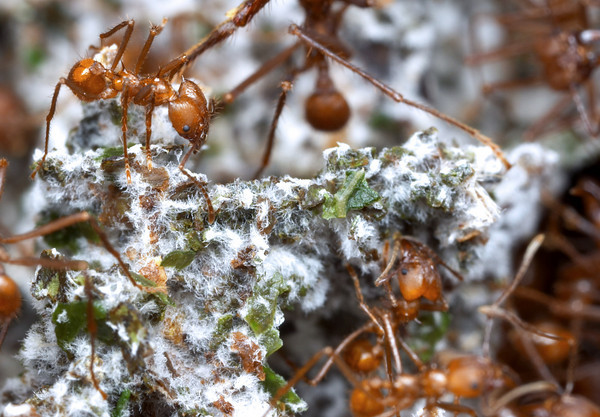Fungal Farming in Leafcutter Ants
Bio342 Fall 2010
by Emily Crotteau
Adaptive Value:
Adaptive value looks at how the particular characteristics of a species give a selective advantage in terms of the evolution of the species. For leafcutter ants and fungus alike, the big question is, "Why should an organism benefit an individual of a different species, if this comes at a short-term cost?" (1).
Adaptive Value for the Ants
For many orchardists in tropical regions, leafcutter ants can be major pests. Their success, often at the expense of human farmers, suggests that the there's are significant benefits for both the ants and the fungus.In general, insects are not able to efficiently digest cellulose, but in fungal gardens, the initial digestive steps are completed by the fungal cultivar. Because digestive enzymes secreted by the fungus are capable of breaking down a wider variety of organic sources, including tough cellulose and starches, the ants gain access to a much wider range of plant-based food sources. Comparisons of leaf cutter ant colonies with those of the lower attines suggest that the close fungal association has supported the development of larger sized colonies with a greater degree of polymorphism (5). This theory is supported by the fact that a similar mutualistic has developed between certain species of termites and Termitomyces fungus (1). Although the evolutionary basis of this relationship is believed to differ greatly from that of the leafcutter ants, that fact that such mutualism has evolved convergently in entirely different orders suggests that it an evolutionary stable development.
Adaptive Value for the Fungi
Not only the ants derive unique and advantageous benefits from this relationship. Whereas free-living fungus must extend their hyphae through substrate to access additional nutrients, ant foragers actively deliver choice substrate to the "domesticated" fungus. Thus it appears that for ants and fungi alike, the development of a mutualistic relationship enabled the occupation of novel foraging niches, optimizing opportunities for food acquisition and colony growth. Leaf cutter cultivars are also protected from parasitic Escovopsis that consume the cultivated fungus beyond what it is able to sustain (9). Moreover, waste products are meticulously removed from the gardens, maintaining sanitary growing conditions.

Figure 8. Atta cephalotes tending to their garden [Photo courtesy of Alexander Wild]